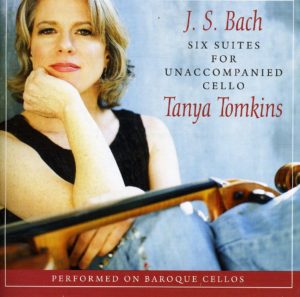
Tanya Tomkins Bach Six Suites For Unaccompanied Cello (Avie AV2212) Recorded 2010
The Cellist.
Tanya Tomkins is apparently adept with both modern and baroque cellos. However, it is with the world of Early Music and Baroque that she is best known. She is the first cellist ever to win the Bodky Competition for Early Music Soloists. Furthermore, she numbers among her teachers the doyenne of baroque cellists Anner Bylsma.
The Recording.
For the current recording the booklet cover states that the Suites are “performed on baroque cellos”. This is a little misleading as the first 5 suites are played on a 1798 Lockey Hill. The one for the 6th Suite is a 5 string cello made in 1985 after an instrument by Matteo Gofriller,1699. Be that as it may, the sound is far more akin to the baroque than modern eras.
The performances themselves do not I feel significantly challenge overall perceptions of the Suites. There are odd notable surprises, however.
Tomkins does also adopt a rather strange ordering of the Suites namely 3,2,6 of disc one, and 5,4,1 on disc two. For sure pacing of performances by different performers does mean that a straight 1-6 set is not overly common. The current approach does seem somewhat removed from the general thrust of playing the Suites in near to their numerical order. Consequently,we have instead of a grand ending to the set from the sixth Suite, the relatively calming and untroubled first Suite.
I couldn’t spot anything in the booklet explaining the choices made here.
The Intepretation.
As to the performances, whilst I made notes for every movement, rather than tackle these head on, I will focus on some generalisations. These occur time and again throughout.
Firstly, they are pretty consistent in being at fairly sedate speeds. Secondly, plenty of rubato is present too. Tomkins takes every opportunity to linger on notes and chordings to savour the rich overtones that ensue. I admit to greatly enjoying these aspects. Unfortunately, I have concern this may reflect a “look what the cello can do” rather than a “look what the music is saying” approach.
I found pleasure in most of the Suites but admit that the 5th does for some reason wash over me. This is despite an arresting start to the Prelude. There are also a number of examples of ornamentation and grace notes occurring which nice as they are does sail close to impeding the flow.
Unusual Choices.
This brings me nicely onto the more unusual choices made in the performances. In the 4th Suite the second Bourree is played pizzicato, which I felt was very effective and provided excellent contrast. Conversely, I was less enamoured by the Double added to the 6th Suite Sarabande (composed by the pianist Eric Zivian, a regular chamber partner to Tomkins). For sure, it is tastefully done, but playing around with my favourite movement of all, especially when I had written up to that point:
“relishes the overtones.”
“leans nicely into chords.”
“pathos abounds.”
“such variety.”
This was always going to bring mixed bag impressions. In the booklet notes John Lutterman comments on the Suites as follows: They should not be intended as “fixed musical works” but for extemporaneous performance. “much in the same manner as a brilliant jazz solo”. From my perspective as a listener the jury is out here, and in any event the Double may stretch extemporaneous performance (in its literal meaning) a bit too far.
Conclusion.
So in summary, I would describe the set as a worthy addition to any listening list, but taken as a whole it doesn’t for me trouble my established front runners.
Mark.